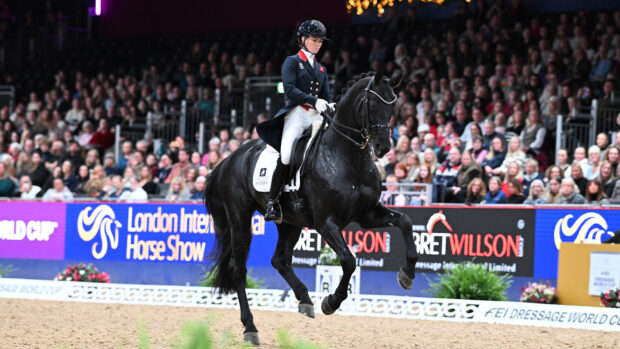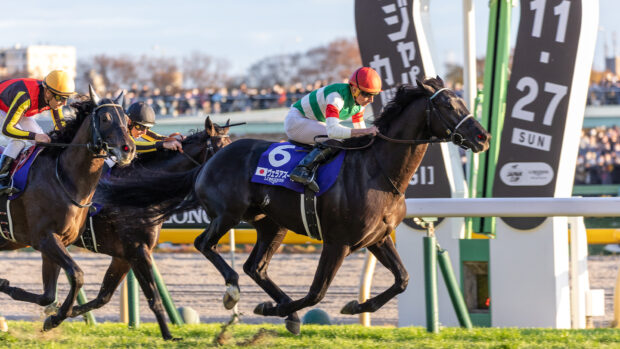How many famous black horses do you know? Tall, dark and handsome – there’s something so irresistible about a black horse. From the Lloyds Friesians galloping across our screens to equine superstars such as Classic Moet and Black Caviar, black horses are blessed with presence and panache.
Such is our captivation with black horses that they have well and truly left their hoofprints in the pages of history. They’ve inspired stories, art and generations of equestrians. We’ve narrowed down the world’s famous black horses to five favourites – though it was a tough call!
1. Bucephalus (4th Century BCE)
We hear about Bucephalus from Plutarch, the Greek historian and philosopher. According to his Life of Alexander, Bucephalus was a wild black horse with a large white star. He was given to Alexander the Great’s father, King Philip II of Macedon. The horse’s name combines the Greek words “bous”, meaning ox, and “kephalos”, which means head.
Bucephalus seemed wild and vicious – no one in King Philip’s court could get anywhere near him. Alexander, only a boy, watched the horse kick and fight and noticed he was afraid of his own shadow. If you’ve ever hacked a spooky horse, you’ll appreciate this!
Alexander turned Bucephalus’ head towards the sun and, shadow obscured, the horse relaxed. Thanks to his observance and patience, the young prince bridled and mounted the unrideable Bucephalus.
Bucephalus became Alexander’s famous war horse. When the horse died in battle at Hydaspes in 326 BCE, Alexander named a nearby city Bucephala (sometimes acknowledged as modern day Jhulem in Pakistan).
The story of Bucephalus is recounted in the 1970s classic film The Black Stallion, and tells the story of a boy who tames a wild horse.
2. Black Beauty (published 1877)
 As famous black horses go, we’re sure you’ll have heard of this one! Black Beauty is the titular character of a beloved children’s novel by Anna Sewell. Anna, born to Quaker parents in 1820s Norfolk, was permanently disabled when she broke both ankles as a child. Her mobility severely limited and her health poor, she spent much of her life assisting with her mother Mary’s writing.
As famous black horses go, we’re sure you’ll have heard of this one! Black Beauty is the titular character of a beloved children’s novel by Anna Sewell. Anna, born to Quaker parents in 1820s Norfolk, was permanently disabled when she broke both ankles as a child. Her mobility severely limited and her health poor, she spent much of her life assisting with her mother Mary’s writing.
She relied on horse-drawn carriages to get out and about and it is said this helped her develop a huge affection and sympathy for horses. She began writing Black Beauty in the 1870s, of which she said “its special aim being to induce kindness, sympathy and an understanding treatment of horses”.
The novel follows Beauty from birth to his final home. Throughout his life, Beauty changes hands many times and suffers a number of trials and tribulations. Most strikingly, Beauty is made to wear a bearing rein while pulling a baker’s cart. This is a device that was used to hitch a driven horse’s head up as high head carriage was the fashion. In the novel, a woman shows the driver how much easier Beauty could manage with his head low. Following the publication of Black Beauty, the use of bearing reins was abolished.
Sadly, Sewell died shortly after its publication in April 1878, but not before she learned of its success. Today, Black Beauty is a 50 million-copy bestseller.
These days, the novel’s cultural impact knows no bounds. There are a host of film and stage adaptations to enjoy and it’s even one of Queen Camilla’s favourites. However, perhaps most significant is that the novel serves as a manifesto for the kind treatment of horses. Bernard Unti, who wrote a chapter on Sewell in Encyclopedia of Animal Rights and Animal Welfare, dubbed Black Beauty as “the most influential anti-cruelty novel of all time”.
3. Burmese (1962-1990)
 Gifted to Queen Elizabeth II in 1969 by The Royal Canadian Mounted Police, Burmese was a striking black mare born in Saskatchewan and trained in Ottawa. It is said the regiment had heard The Queen was looking for a new horse. Thus, Burmese was presented to Her Majesty at the Royal Windsor Horse Show in 1969.
Gifted to Queen Elizabeth II in 1969 by The Royal Canadian Mounted Police, Burmese was a striking black mare born in Saskatchewan and trained in Ottawa. It is said the regiment had heard The Queen was looking for a new horse. Thus, Burmese was presented to Her Majesty at the Royal Windsor Horse Show in 1969.
Burmese was a horse for business and leisure. Queen Elizabeth was often seen on board Burmese whatever the weather during stays at country houses, but most famously the mare was the Queen’s chosen mount for Trooping the Colour 18 years in a row until her retirement in 1987. Burmese was buried in the grounds of Windsor after her death in 1990.
During Trooping the Colour of 1981, Burmese was famously spooked by a teenager firing blanks at her royal rider from the crowd. Burmese was understandably unsettled but The Queen, riding side saddle, handled her horse expertly.
4. Sefton (1963–1993)

Sefton in 1984 with Shaun Measures
If you’re looking for famous black horses with hero status, then look no further. The part-bred Irish Draught was purchased by the Army as a four-year-old and was assigned to the Household Cavalry Mounted Regiment. During his time at the barracks, he received the nickname “Sharkey”, which alluded to his penchant for biting.
Sefton gained a reputation for being difficult, and was sent out with the Blues and Royals on deployment in Germany with great success. In fact, he even competed in showjumping while posted out there.
However, Sefton became a beacon of resilience and bravery in July 1982 following the detonation of an IRA nailbomb in Hyde Park. Sefton and 15 other horses were participating in the changing of the guard when the incendiary went off. Tragically, two soldiers were killed at the scene and a further two died later of their wounds. Meanwhile, all the horses were wounded, with seven put down at the scene. However, Sefton was the most severely hurt.
Following eight hours of surgery – a record for a horse at the time – Sefton returned to his duties for a further two years after convalescing at the Veterinary Hospital of the Royal Army Veterinary Corps and the Defence Animal Centre, Melton Mowbray.
Sefton received countless cards and mints during his hospital stay. Plus, the public raised more £620,000 for the new Sefton Surgical Wing at the Royal Veterinary College.
Following his retirement to the Home of Rest for Horses in Speen, Buckinghamshire, Sefton’s lived until he was 30, when complications that arose from his injuries took their toll. He was one of the first horses inducted in the British Horse Society Equestrian Hall of Fame in 2005.
5. Totilas (2000-2020)

Totilas, pictured at the 2010 World Equestrian Games where he won three gold medals.
This black stallion heralded a new era of dressage when he burst onto the grand prix scene with Dutch rider Edward Gal in 2009. Famously, “Toto” was the first horse to score more than 90% in a grand prix test. Later that year, at Olympia, the pair broke the freestyle record to score 92.3%. Following their success, Edward and Toto cleaned up a the 2010 World Equestrian Games in Kentucky. However, this was to be their last championship as the stallion was sold to Germany shortly after.
Matthias Rath was given riding rights when his step mother, Ann Kathrin Lissenhoff, bought shares in Totilas. Rath and Toto won their first grand prix and special at München-Reim in 2011, but the horse retired in 2015 following a disappointing score of 79.571% in Aachen and concerns for his soundness.
Following a five-year retirement spent hacking and at stud, Totilas died as a result of a serious colic episode.
Who is your favourite famous black horse? Write to us at hhletters@futurenet.com including your name, nearest town and county for the chance to have your thoughts published in H&H magazine
You may also be interested in…
“The partnership and the silhouette of Edward and Toto became iconic, something those of us lucky enough to see them

The Household Cavalry: its history, the regiments and the famous Cavalry Black horses

‘A wonder horse who changed dressage’: top riders’ tributes to Totilas

The Queen’s favourite horses – 8 riding horses and 5 racehorses #H&HArchives

Subscribe to Horse & Hound magazine today – and enjoy unlimited website access all year round
Horse & Hound magazine, out every Thursday, is packed with all the latest news and reports, as well as interviews, specials, nostalgia, vet and training advice. Find how you can enjoy the magazine delivered to your door every week, plus options to upgrade your subscription to access our online service that brings you breaking news and reports as well as other benefits.




